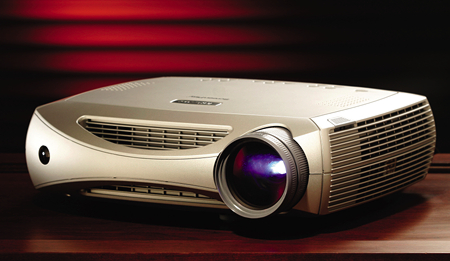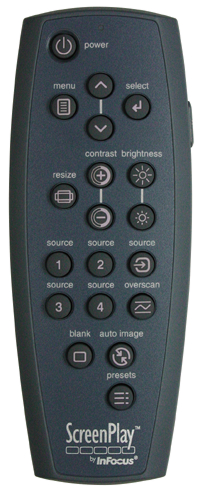InFocus 7210 DLP Projector
It has been interesting to follow the development of the 7200 Series from InFocus. Two years ago, I reviewed the 7200, the first high-end home theater projector from what was, up to that point, a company primarily known for business projectors. A year later came the 7205, which had some updates, including a new chip from Texas Instruments. It was brighter, had a better black level, and was cheaper. Now, a year after that, the 7210 follows this same progression.
A Bit of History
DLP is a quickly maturing technology, but Texas Instruments has sown the seeds of confusion by changing the names of the chips at the heart of all DLP displays. The generation after the HD2+ (1,280 by 720) was originally called the HD3, but TI then dropped the HD nomenclature altogether and began calling the new chip the 720p. (They also have a 1,920-by-1,080 chip called the 1080p, which was originally called the xHD3. Interestingly, that chip has only 960 mirrors in the horizontal dimension, and each one forms the image for two adjacent pixels,which totals to 1,920 by 1,080 pixels on the screen. The 720p has a full complement of 1,280 by 720 mirrors.) Not only that, these chips are available with one of two sets of image-enhancing technologies, either DarkChip2 or DarkChip3.

Whereas the 7205 used the HD2+ chip with DarkChip2, the 7210 uses the 720p chip with DarkChip3. Among the differences between the HD2+ and 720p chips is reduction in space between the mirrors, which provides even more controllable surface area to reflect the light. Also, each mirror's "dimple" has been reduced even further, which means that each mirror can individually reflect more light. Lastly, there is a new light-absorbing coating underneath the mirrors. This should all lead to a better black level, more light output, and, therefore, a better contrast ratio.
How Much Better?
The 7210 has a better black level in its regular lamp mode than the 7205 does in its regular lamp mode. At the same time, the 7210 is brighter in its regular lamp mode than the 7205 is in its high lamp mode. The decrease from 0.019 foot-lamberts to 0.018 ft-L isn't huge, but the increase from 22.37 to 25.62 ft-L is decent. The kicker is that the 7210 produces better blacks and brighter light output at the same time. As you can see in the measurement chart, the 7210 produces 0.018 ft-L and 25.62 ft-L at the same setting. The 7205 produces either a similar black level or a similar light output, but not at the same time. Because of this, the 7210 has a 40-percent measured increase in contrast ratio. Impressive.
Keep in mind, though, that 0.018 ft-L is still fairly high. The average black level for all the projectors we've reviewed since we started our contrast-ratio measurements is a little more than half that amount. Most of the high-end DLP projectors have black levels that are a sixth of that (i.e., 0.003 ft-L). But the increase in contrast ratio, not to mention the incredible light output, allows you to use this projector with a truly enormous screen. I'm talking drive-in-movie enormous. You could easily use a screen more than 10 feet wide (138 or so inches diagonally) and still have a brighter image than many of the projectors that come through here. That size screen would then reduce the black level to a number comparable to that of the darker DLP projectors.
InFocus realizes that not everyone can fit a car-sized screen in their living rooms. To this end, the 7210's lens is threaded to accept 72-millimeter camera filters. A fairly dark, neutral-density filter would darken the picture nicely. These filters are pretty easy to find and are not terribly expensive (usually less than $50). The best part of this arrangement is that, if you want to go back to the brighter picture, say for daytime viewing, the filter unscrews easily. Or, if you want a really deep black level for movies and a different black level for TV, you could get a different filter for each. Would it be best if the projector did all of this internally? Maybe, but what fun would that be? Also, the price of this projector and two filters is several thousand dollars cheaper than any other high-end DLP projector.
What About Everything Else?
Processing is excellent. The 7210 picks up the 3:2 sequence quickly. It processes video with minimal, if any, artifacts. During the image-montage section of Video Essentials (chapter 19), there is a waving flag against a brick-building background. Displays with poor video processing make the curvy lines in the flag look jagged. Some displays also cause the background to flicker as they try to process the scene. The 7210 had none of these issues and made this scene seem filmlike.
 More and more displays are taking our DVD "torture disc" and laughing at it. The DTS Demo Disc No. 3 Apollo 13 torture clip starts with a pan across a motel parking lot. The problem with this scene is that the 3:2 sequence is messed up, so many processors can't figure out that it's film and start combining the fields like it was video. This causes tons of jagged edges, stair-stepping, and combing on the hotel sign and balconies. The 7210 produced a very slight amount of jagged edges on the sign, which is about as good as any display we've had in here. On the next shot in the demo, one of the astronauts' wives is in the shower. (Hey, get your mind out of the gutter.) Because there is so little video movement between the fields (she's just standing there), many processors again assume that the scene is video. As soon as she starts moving, her face and hands exhibit combing. Here, the 7210 saw through the ruse and showed the scene as the film content it is. The 7210 also scales well, making DVD images appear sharp and detailed.
More and more displays are taking our DVD "torture disc" and laughing at it. The DTS Demo Disc No. 3 Apollo 13 torture clip starts with a pan across a motel parking lot. The problem with this scene is that the 3:2 sequence is messed up, so many processors can't figure out that it's film and start combining the fields like it was video. This causes tons of jagged edges, stair-stepping, and combing on the hotel sign and balconies. The 7210 produced a very slight amount of jagged edges on the sign, which is about as good as any display we've had in here. On the next shot in the demo, one of the astronauts' wives is in the shower. (Hey, get your mind out of the gutter.) Because there is so little video movement between the fields (she's just standing there), many processors again assume that the scene is video. As soon as she starts moving, her face and hands exhibit combing. Here, the 7210 saw through the ruse and showed the scene as the film content it is. The 7210 also scales well, making DVD images appear sharp and detailed.
HD content is more of the same. Everything is sharp and detailed, with very little, if any, video noise. There is even aspect-ratio control for every resolution (a rarity). Like its predecessors, the 7210 has among the best processing in the category. You can even choose between three different overscan levels: zoom, crop, and off. (Earlier models just had on and off.)
On the other hand, color isn't this projector's strong suit. It's not bad, but it is not nearly as accurate or as vibrant as several other projectors we've had in recently. When you look at them on their own, the colors don't appear off, but they don't look exactly right, either. Scenes like chapter 5 of The Fifth Element, where there are many differently colored objects (like the hallways, the fish, and so on), just don't grab you like they do through some other projectors.
The 7210 is also fairly loud, noticeably louder than other projectors. That's not surprising, given that the case is open to the elements on both sides. If you don't plan on mounting this projector, plan on keeping it as far away from your seating area as you can.
The remote is the same model that comes with the other projectors in the 7200 Series. It's oddly shaped, but it gets the job done. It's backlit, using a button on the side, which also turns the backlight off with an additional click, conserving battery life. Programmable direct input-access buttons are here and should be on every display's remote.
So What's the Damage?
It's hard not to recommend the 7210. At $6,999, it is so much cheaper than its competitors, you really can't put it in the same category. It falls in a sort of middle ground, not as expensive as the single-chip big dogs but significantly more expensive than even the upper-echelon budget projectors. For the level of performance the 7210 offers, it's quite a bargain. I wish it had an iris, although that would certainly bump up the price. In the meantime, the ability to add a filter to tailor the light output to your needs and wants offers a level of customization that is hard to find in many projectors costing much more (although those models often do so internally). I'd also like to see more accurate color points. This might seem like a simple fix, but it would reduce light output considerably. And really, that's what the 7200 Series is all about. Like its predecessors, the 7210 is for the person who wants to get the absolutely largest screen possible and put an excellent image on it. And really, who doesn't want that?
Highlights
• The brightest projector ever . . . again
• The price is lower than that of the model's predecessor
- Log in or register to post comments




































































